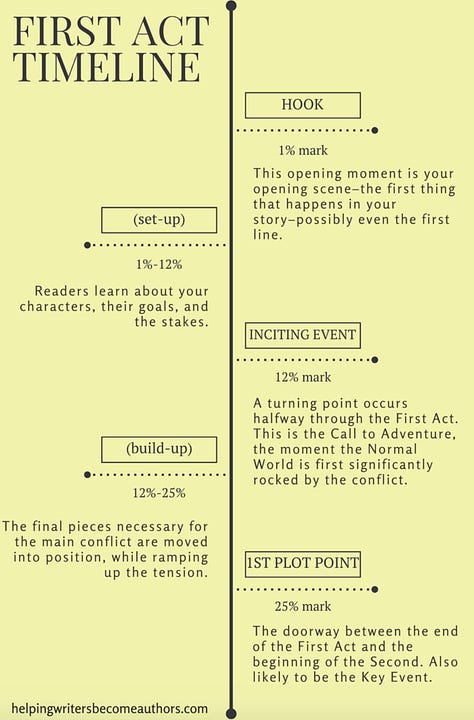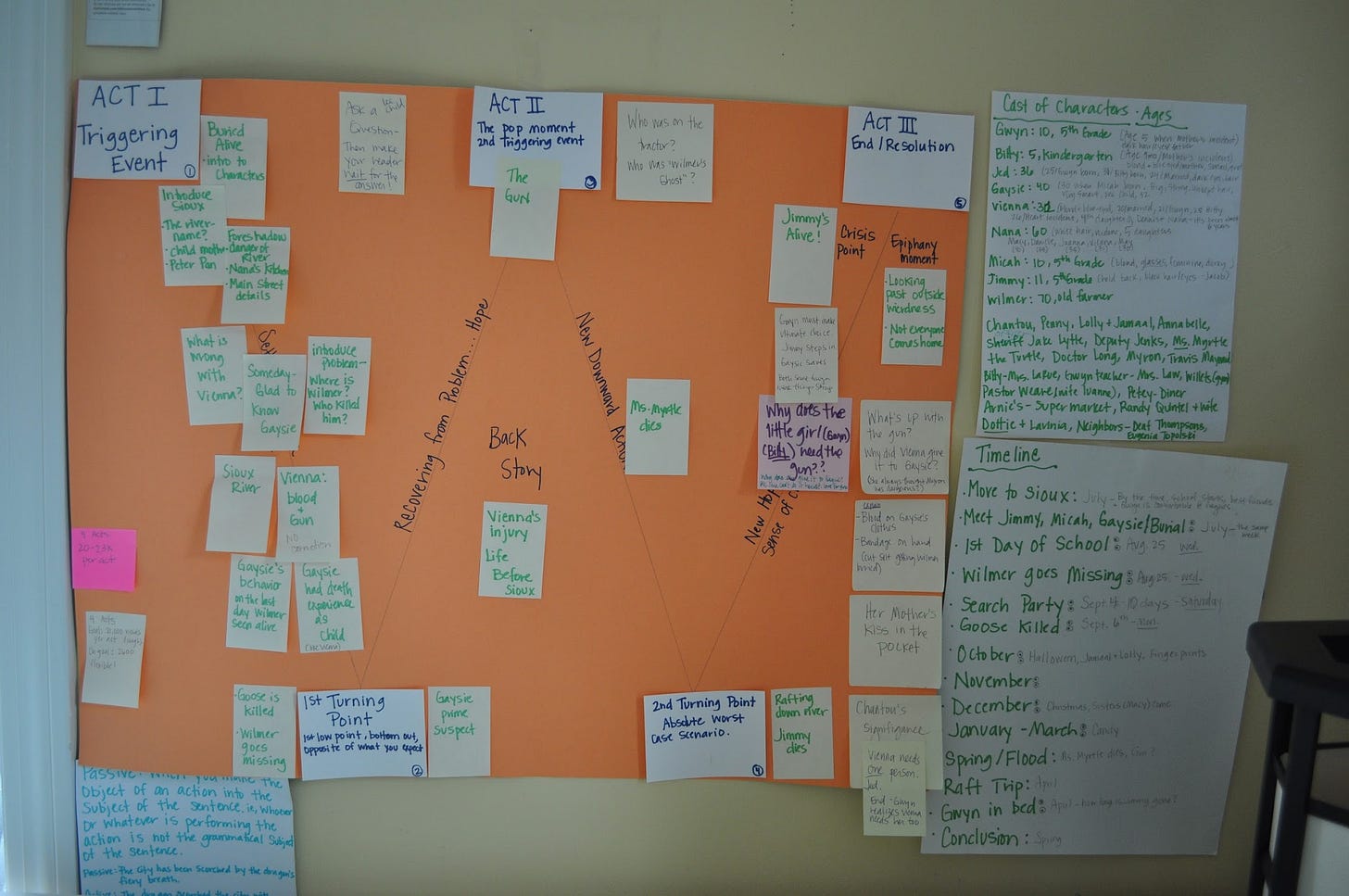How I Learned to Structure a Novel
this simple formula will help you write your book
Nearly sixteen years ago I attempted to write my first novel. Like most first novels, it was basically a glorified autobiography. And in many ways, I’m glad I didn’t know what I didn’t know. It might have scared me too much to try. Ignorance can be bliss.
One of my favorite writing maxims is from Stephen King’s ON WRITING: Write with the door closed shut, edit with the door wide open. This is what I did (I hadn’t yet read his book). I wrote and wrote and wrote. I set the buzzer for one hour during the baby’s nap time every day, with the baby monitor on and the door metaphorically shut tight, letting no seed of criticism or self doubt get planted.
I wrote until I began to think maybe I really am writing a novel. I wrote until the story was over, at nearly 76,000 words. It took me about three months to finish. I typed The End and thought where’s the literary agent?!
Oh, sweet lass.
Sixteen years later and that book is not published - but new and better ones emerged!
It was a very important practice novel. But I had to learn something very important: structure. A structure beyond Beginning Middle End.
Thus began a great study.
One of the first books I read for the purpose of paying attention to story structure was Jodi Picoult’s MY SISTER’S KEEPER. I wrote all over the book, kept a yellow legal pad for notes, and did much pondering on “why and how” the book worked.
In retrospect, it was perhaps not the best book to pick as it has multiple points of view and is not easy to pull off even for the most skilled of novelists…!
I read more books, googled “story structure,” read “how-to” books from authors like Larry Brooks and literary agent Donald Maass. I made posters to keep track of rising and falling action in an attempt to understand the three-act structure.
It was slow learning. How my brain works: it takes awhile, but when I get it, I GET it (ex: learning to read in first grade and learning algebra, oy).
The light bulb moment was discovering K.M. Weiland and her award-winning website Helping Writers Become Authors. The way she writes and articulates story structure makes sense to me.
I’m going to share her process and hope it helps you, too.
Let’s say you’re writing a novel for adults and you want the word count to be close to 80,000 (a solid adult-length novel goal).
Divide the Word Count by 8 (why? Because there are eight crucial structural elements needed to make a story work)
80,000 divided by 8 = 10,000
So…each section of the novel needs to roughly be 10,000 words
This is how you would use the word count within eight structural elements:
Hook to Inciting Event: 0-10,000 words
Inciting Event to First Plot Point: 10,001-20,000
First Plot Point to 1st Pinch Point: 20,001-30,000
1st Pinch Point to Midpoint: 30,001-40,000
Midpoint to 2nd Pinch Point: 40,001-50,000
2nd Pinch Point to 3rd Plot Point: 50,001-60,000
3rd Plot Point to Climax: 60,001-70,000
Climax to Resolution: 70,001-80,000
I used 80,000 words because you can see from the above that it makes it very easy to divide (remember me and algebra).
Now that you have the magic number of 10,000 in your head, you can divide that into chapters. You could have ten chapters from the Hook to the Inciting Incident that are each 1000 words each. My brain likes this way of thinking. It’s organized, but not confining. The structure is how I feel freedom to write. Those 1000 words are a small chunk that can be written in one writing session. Of course your chapters can be longer or shorter - you get to decide what to do with those 10,000 words inserted between two major story pillars.
When I’m first starting a new story idea, I will often just plunk down a few words in each chapter. Or maybe we know what needs to happen at the midpoint (Mr. Darcy proposes to Lizzy!) so we plunk down that sentence and now we have something juicy to head toward.
Let’s say you’re writing a middle grade book and you want the word count to be 60,000 words. Same thing:
Divide 60,000 by 8 = 7,500 words
So, there needs to 7,500 words between each story element
Does every book follow this exact story structure? Well, this is very interesting. Could this be true when Jane Austen didn’t have K.M. Weiland explaining story structure to her? If you read Pride and Prejudice, you will see each and every plot point where it should be. The story is so satisfying to readers because the story hits the major and necessary structural elements, AND of course Austen knew how to craft exceptional characters that we either love or detest in the best way.
There is a formula that leads to a satisfying story end. The plot points land well and keep the reader engaged. This does NOT mean “formulaic.” It means that the bones are good, the structure is solid, the ending pays off.
Is there any wiggle room? Yes! Let’s say The First Plot Point (where everything changes for the hero, launching him/her into the adventure) is “supposed to be” at 25%. That’s just something to aim for. If it lands at 20 or 30%, that’s okay. But launch your story too early with the First Plot Point and your readers might not be invested in yet; launch it too late, and your readers will start to get bored, wondering what the point of the story is.
THE HUNGER GAMES: the hook is Katniss’s world of hunger and hunting and a fragile mother and little sister to care for. The inciting event is Katniss volunteering as tribute for her little sister. The First Plot Point is when a fake romance between Katniss and Peeta begins and they enter the games. We are totally invested. There is no turning back now…not for us and not for Katniss, Peeta, and Gale…
How about STAR WARS? (look for story structure in film!) The First Plot Point is when Luke discovers his home has been torched and his aunt and uncle are dead. There is nowhere to go but embrace the new world he’s been thrown into. A hero must embrace his destiny…
Isn’t this just the hero’s journey? YES. It’s just explained in a slightly different way that makes sense to my brain. What if you don’t know what each story element means? What’s a First Pinch Point and what should happen at the Midpoint? What is the 3rd Plot Point? Click and start readin’!
Weiland also has a terrific podcast with over 600 short, bite-sized episodes about everything story, my favorite episodes being the ones on story structure.
If you want to see a breakdown of movies and books according to story structure, have a look at this link. Once you start seeing the structure, you’ll start paying attention to everything you read and see on the screen - it’s fun and enlightening.
It’s also hugely helpful because if we know where we’re going, the novel becomes a tad less daunting.
Know this: at the end of it all, you’ll still have a very rough and terrible first draft, but you’ve written a novel! And editing is much more fun than the blank page. It’s also a whole lot better than getting to the end of 100,000 words and having a gigantic mess with zero structure.
Remember that this is ONLY a guideline. Story structure is your servant, NOT your master! You are the captain of your fate - and that of your book.
Are you a visual person like I am? CLICK HERE for infographics. You can print and hang above your writing desk like I do (scroll down the infographics page and you’ll find the three acts with a brief explanation of each story structure element). The photos below are cut off due to Substack’s photo “gallery view” feature.



I’ll have to do a post on how I use this structure with Scrivener software for my very first draft before transferring it all over to Google docs.
I recently read, ”NEW YORK — More than half of Americans think they've got a good idea for a novel in them, but most have never attempted to write one.” -study.org
Well, this could be your year. With a little structure, you’re ready to start!
I hope this is helpful. If you have questions, I’ll try to answer them. Comment below or add your wisdom to the chat - maybe you have a different way of understanding story structure…
Amy 💗
Good News and Story Links
Yippee: World Read Aloud Day is Tomorrow and I’m excited to meet all the kids!
Excited for: Going to Georgia for the first time
Saw this movie over the weekend: A Man Called Otto (loved it; cried)
The cutest mini books:





This is so helpful and just what I needed! Thank you so much!!